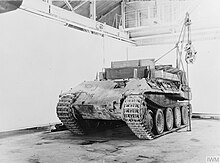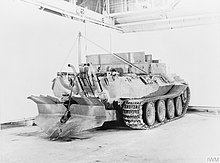Bergepanther

The armored vehicle "Panther" (Sd.Kfz. 179), often referred to simply as "Bergepanther", was a variant of the armored vehicle V Panther (Sd.Kfz. 171) that had been converted into a armored recovery vehicle .
Development and production
The idea of a Bergepanther came about in 1943 because of problems with the recovery of heavy and medium tanks. The development was carried out by MAN. The half-track vehicles (e.g. Sd.Kfz. 9 ) used for recovery up to that point were rarely able to successfully recover a panther or a tiger ; towing with another Tiger or Panther was strictly forbidden as this could lead to the loss of both tanks.
The first Bergepanthers were almost completed Panthers of the Ausf. D, where the manufacturer MAN only omitted the tower. Henschel, Daimler-Benz and DEMAG later took on the production one after the other. The specially produced hull of the Bergepanther was largely similar to that of the Panzerkampfwagen Panther, although the modifications of the Ausf. G were adopted at the end of 1944. The crew consisted of at least three soldiers, with the device being operated by two soldiers in the vehicle.
There were now square wooden and metal superstructures where the turret of the battle tank was, and a winch with a longitudinal pulling force of 40 tons was embedded in the hull of the tank. A large earth spur at the stern was used for support. Furthermore, the Bergepanther had a simple crane boom with a load capacity of 1.5 tons.
The Bergepanther was quite reliable in its field of activity and, thanks to its armor, could also be used under enemy fire. Even the heavy tiger and its variants could be recovered without any problems by a Bergepanther with a winch.
After the Second World War, the British described the Bergepanther as "usable" based on their own experiments.
In addition to the on-board MG, which could be attached to supports to the right or left of the combat area, the Bergepanther received a bow mount to accommodate a 2-cm KwK-30 automatic cannon. However, this ceased to exist in 1944. With the conversion to the hull shape of the Panther G, the Bergepanther received the usual MG ball cover on the radio operator's side. The machine gun support on the driver's side was also omitted.
From 1943 to 1945 around 339 Bergepanther of all designs were produced by MAN , Henschel , Daimler-Benz (Berlin-Marienfelde plant) and DEMAG .
Of the vehicles designated as Bergepanther, a total of around 297 Bergepanther were built from September 1943 onwards with the special Panther tub, which enabled the cable winch and the spur to be accommodated. Of these 297 mountain panthers, at least 88 were delivered without a winch and spur. Apart from the 42 vehicles designated as Bergepanther up to September 1943, which were essentially only turretless Panther chassis of the D version as tugs, the company Seibert Stahlbau in Aschaffenburg took on the conversion of damaged, damaged vehicles from August 1944 to March 1945 Panthers of version D returned for repair to Bergepanthern ("Umbau-Bergepanther"). These vehicles also had neither a winch nor a spur and thus resembled the first mountain panthers from MAN and Henschel. The cover with the hatch covers for the driver and radio operator has been omitted. They were provided with all other recovery equipment and tools that could also be found on the Bergepanther. The Seibert company produced (approximately) 61 conversion mountaineering panthers. A total of about 113 vehicles were delivered from the repair.
It can be seen here that the vehicles referred to as Bergepanther were for the most part just turretless towing vehicles that were delivered until the end of the war. Furthermore, a significant part of the Bergepanther with the special tub for winch and spur attachment was probably only used as a towing vehicle due to the lack of winches.
These facts, which only became public in 2013 through the latest publication on the subject of Bergepanthers, may have contributed to the fact that "early" Bergepanthers were incorrectly identified in various earlier publications, including photos from the end of the war.
Technical specifications
- Armored recovery vehicle "Panther" (Sd.Kfz. 179)
- Year of construction: 1943–1945
- Dimensions (with aprons and spur)
- Length: 8.86 m
- Width: 3.42 m
- Height: 2.70 m
- Combat weight: 43 t
- Engine: 12-cylinder Maybach HL 230 P30 gasoline engine , 23.1 l
- Power: 700 hp, throttled to 600 hp
- Top speed:
- 55 km / h at maximum speed
- 46 km / h at throttle speed
- 25 km / h average road speed
- 15 km / h terrain
- Driving range: road approx. 320 km / terrain approx. 160 km
- Tractive force of the vehicle, measured in the test:
- with loose sand: 196 kN (20 t), with snow grippers: 264 kN (27 t)
- Winch:
- Manufacturer and production figures:
- MAN, Nuremberg, June 1943, 12 pieces (without winch and spur on the chassis with the tower opening covered by a sheet metal cover from the ongoing production of the Panther Ausf. D)
- Henschel, Kassel, July 1943 - November 1943, 70 pieces (the first 30 pieces as before at MAN, the last 40 pieces with the special Bergepanther tub version A, without winch and spur)
- Daimler-Benz, Berlin-Marienfelde, February 1944 - March 1944, 40 pieces (like the last 40 pieces at Henschel, but also without winch and spur)
- Demag, Berlin-Falkensee, March 1944 - October 1944, 123 pieces
- Demag, Berlin-Falkensee, October 1944 - February 1945, 94 pieces (modified Bergepanther tub based on the Panther type G tub)
- At least 88 of the Bergepanthers with special tubs were delivered without winch and support spur.
- Manufacturer of the special Bergepanther armored housing:
- Ruhrstahl, Hattingen
- Possibly. Dortmund-Hörder Hüttenverein, (DHHV), 10 pieces in August 1943 (not yet verified)
See also
literature
- Rolf Wirtgen (Ed.): The repair of the Bergepanther. Overview and status report April 2004. Federal Office for Defense Technology and Procurement, Koblenz 2004, ISBN 3-927038-65-2 .
Web links
Individual evidence
- ^ Frank Köhler: The manufacture of tracked vehicles at the MNH company in Hanover from 1939–1945. In: Association of Friends and Patrons of the Defense Technical Study Collection Koblenz , first published in 1994, online since October 22, 2011, accessed on December 18, 2017.
- ↑ Rolf Wirtgen (ed.), Frank Köhler: The manufacture of military vehicles and individual parts at the MNH group of companies in Hanover from 1939 - 1945, post-war tank production and testing by the British Army. Federal Office for Defense Technology and Procurement, Defense Technology Study Collection. Koblenz 2008, DNB 991587170 .
- ↑ Jentz, Doyle: Panzer Tracts No. 16. Bergepanzerwagen - Bergepanzer 38 to Bergepanther. Boyds MD 2004, pp. 16-22, 16-32; Spielberger: The Panzerkampfwagen Panther. Stuttgart 1977, 5th edition 1999, pp. 200-214.
- ↑ Jentz, Doyle: Panzer Tracts No. 23. Panzer Production from 1933 to 1945. Boyds MD 2011, pp. 23-61.
- ↑ Jentz, Doyle: Panzer Tracts No. 16-1, Bergepanther Ausf. D, A, G. Boyds MD 2013, pp. 16-1-5; 16-1-8 - 16-1-19; Purchase of WAA = 339 pieces. (06/43 to 02/45), of which 42 pieces. Panther tubs from MAN and Henschel (06 / 43-09 / 43)
- ↑ Jentz, Doyle: Panzer Tracts No. 16-1, Bergepanther Ausf. D, A, G. Boyds MD 2013, pp. 16-1-7.
- ↑ Jentz, Doyle: Panzer Tracts No. 16-1, Bergepanther Ausf. D, A, G. Boyds MD 2013, pp. 16-1-19; 16-1-51 - 16-1-54.
- ↑ Jentz, Doyle: Panzer Tracts No. 23. Panzer Production from 1933 to 1945. Boyds MD 2011, pp. 23-76.
- ↑ Jentz, Doyle: Panzer Tracts No. 16-1, Bergepanther Ausf. D, A, G. Boyds MD 2013, pp. 16-1-5.
- ↑ Jentz, Doyle: Panzer Tracts No. 16-1, Bergepanther Ausf. D, A, G. Boyds MD 2013.
- ↑ Name after: Jentz, Doyle: Panzer Tracts No. 16 armored recovery vehicles. Boyds MD 2004, ISBN 0-9744862-5-6 , pp. 16-22.
- ↑ Rolf Wirtgen (Ed.), Frank Köhler: Technical description and curriculum vitae of the Bergepanzer Bergpanther exhibit. Federal Office for Defense Technology and Procurement, Defense Technology Study Collection. Koblenz 2009, DNB 995635374 , pp. 12-14, Die Erprobung des Bergepanthers 1944.
- ↑ Jentz, Doyle: Panzer Tracts No. 16-1, Bergepanther Ausf. D, A, G. Boyds MD 2013, pp. 16-1-5.
- ↑ Jentz, Doyle: Panzer Tracts No. 16-1, Bergepanther Ausf. D, A, G. Boyds MD 2013, pp. 16-1-7.
- ↑ Jentz, Doyle: Panzer Tracts No. 16-1, Bergepanther Ausf. D, A, G. Boyds MD 2013, pp. 16-1-5f.

